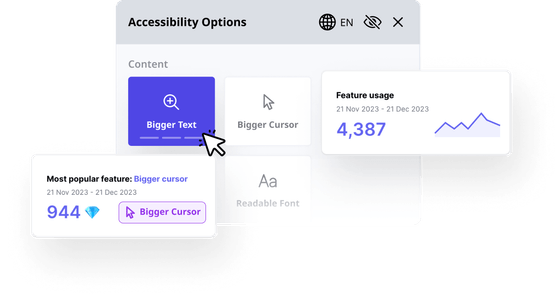Celebrated in July, Disability Pride Month recognizes the contributions of the disability community and reinforces the message of inclusivity. Whether you have a cognitive, mobility, visual, or complex hearing impairment, Disability Pride Month sheds light on the importance of web and physical accessibility for a more inclusive and accessible future.
Keep reading to learn more about Disability Pride Month, including what it is, its historical context, how to celebrate by participating in/sponsoring local events and a Disability Pride parade, and much more.

Introduction to Disability Pride Month
Disability Pride Month celebrates the achievements of disabled people while advocating for physical and web accessibility. Its purpose is to advocate for disabled rights, foster inclusivity, and raise awareness about why physical and digital spaces must be optimized for disabled people in a true testament to human diversity.
Part of the broader Disability Rights Movement in the 1960s and 1970s, it fought alongside the Civil Rights Movement to advocate for improved representation across the public spheres in areas such as employment and public accommodations.
Key legislative efforts included the Rehabilitation Act of 1973, which prohibited discrimination based on disability at the federal level. A separate piece of legislation, Section 504, concentrates heavily on accessible classrooms and workspaces for disabled people.
A third key piece of Disability Pride history lies with the Americans with Disabilities Act of 1990, which created a more comprehensive legal framework banning discrimination against people with disabilities. It also issued provisions on accessibility best practices across telecommunications, transportation, and other public areas with required accommodations like wide entryways and wheelchair ramps. What a way to empower people and promote visibility for the disabled!
Note: there is no designated “Disability Pride Day,” as this proud celebration lasts an entire month. It also has its own Disability Pride flag, a sideways band of five colored stripes with slight lightning bolt shapes, which was invented in 2019 by Ann Magill, an award-winning artist with cerebral palsy.
[Devs: when publishing, please include an image of the flag here. Link to the source in the caption.]
How to Enjoy Disability Pride
Disability Pride is an annual event that celebrates the achievements of individuals with disabilities and the greater disability community. From a Disability Pride parade to sponsoring social media posts, here are three of our favorite ways to acknowledge Disability Pride and its history.
Local Events
One of the best ways to celebrate Disability Pride and raise mainstream awareness is to attend local disability-related parades and events. These events offer everything from advocating for increased funding for advocacy groups to raising awareness on crucial issues. If you have extra time, sign up as a volunteer to support. Don’t forget to fly the Disability Pride flag for a natural and beautiful part of the celebration.
Sponsorship
Another way to celebrate Disability Pride is to become an actual sponsor. If you’re a small business or organization with or without employees, you can draft the sponsorship agreement and reach out to organizations interested in funding.
One of the best ways to explore sponsorship opportunities is by visiting your local disability community resource center.
Funding
Let’s talk about providing funding or resources to private or public organizations looking to increase compliance, advocate for law, and integrate the disabled community into society better.
For example, a local community center could benefit from newly constructed handicap spaces, modified wheelchair ramps, or Braille in each elevator for the visually impaired.
Advocacy
Another way to fully immerse yourself in Disability Pride Month is to recognize three notable organizations that serve as resources for people with disabilities. Let’s highlight voices and disability advocates for the disabled community!
Three inclusion organizations include the Americans with Disabilities Act (ADA) National Network and the Disability Rights Education & Defense Fund (DREDF).
The ADA National Network’s goal is to provide people with disabilities, organizations, and businesses with all the tools they need to increase accessibility, such as ongoing technical assistance, fact sheets, and referral services with a toll-free hotline. The network also plays a crucial role in disability-related research to inform governmental policy at the state and federal levels.
Regarding facilities, the ADA National Network manages 10 regional centers throughout the country, providing much-needed localized support to small businesses and organizations who may or may not enjoy Disability Pride month. Enjoy positive pride regardless!
The second organization, Disability Rights Education & Defense Fund (DREDF), operates differently. It primarily focuses on legal advocacy for people with disabilities to combat discrimination claims in all communities, creating a more inclusive society. In addition, the DREDF advocates informing public policy and offers similar training programs and resources to the ADA National Network.
Lastly, Disability Pride Month cannot be celebrated without mentioning the American Association of People with Disabilities (AAPD), which organizes dozens of events and activities to celebrate the larger disabled community. One of its more popular programs is the REV UP Campaign, which seeks to educate and inspire people with disabilities of all religions and socio-economic backgrounds to vote and make themselves indispensable parts of the electoral process.
In short, these organizations are very effective in advocating for the rights of people with disabilities, including sensory disabilities.

Implementing Disability Inclusion Practices
Arguably, our favorite way to enjoy Disability Pride Month is to set actual examples of increasing ADA and WCAG compliance in physical spaces, websites, and mobile applications.
Here are several inclusive practices to consider as part of your next Disability Pride Day or Month program:
Conduct Accessibility Audits
One of the best ways to increase compliance quickly is by conducting accessibility audits. These audits use automated and manual tools to scan your website and rely on user feedback to identify problems and solve issues.
Two of our favorite automated testing tools are WAVE and Axe, which offer a robust suite of scanning tools. They provide in-depth accessibility reports that assign grades and tell you what to improve. They identify many issues quickly and provide consistency across results in an easy-to-read interface.
However, one limitation of WAVE and Axe is that they will not catch every accessibility issue. We recommend incorporating manual testing to solicit feedback based on website or mobile application interactions.
Another way to enforce your accessibility audits is via manual testing, which relies on human evaluation. This could be in focus groups or surveys that quiz users on all aspects of your website or mobile application experience, such as keyboard navigation, screen reader testing, visual inspection, and much more.
Manual accessibility testing provides an extra way to get in-depth feedback using real-world scenarios while addressing many minor accessibility challenges. However, it’s typically more expensive than automated testing and requires more time. Facilitating these sessions requires a dedicated understanding of web accessibility and best practices.
Ensure Accessible Content
One of the best ways to comply with web accessibility is by ensuring accessible content and media for the disabled. Adhere to web content accessibility guidelines with best practices like alternative text for images, audio captioning, and accessible PDFs, which are essential file types.
Do not forget about using assistive technologies, which amplifies the experience for people with disabilities. Some examples include screen readers like JAWS (Job Access With Speech), NVDA (NonVisual Desktop Access), and VoiceOver (macOS/iOS), as well as screen magnifier technologies like ZoomText and MAGic.
Braille displays like the Brailliant and Focus series allow users to read online content line by line. They don’t need an internet connection and are specialized devices that use pins to make out Braille “letters.”
With roughly 15% of the world’s population suffering from a partial disability, creating accessible content makes perfect sense. Don’t forget about Accessibly, our web accessibility widget that allows you to increase compliance with ADA and WCAG guidelines instantly. What a way to enjoy Disability Pride Month!
Meet Web Content Accessibility Guidelines
In our opinion, one of the best ways to celebrate Disability Pride Month is by focusing on the Web Content Accessibility Guidelines (WCAG), a series of best practices designed to ensure that people with disabilities can engage with websites and mobile applications. Backed by the Americans with Disabilities Act (ADA), it’s the law.
When applying these guidelines, concentrate on their core principles to improve the disability experience: Perceivable, Operable, Understandable, and Robust. Each principle drives improvements in how information and user interfaces are presented, how they function, how they are understood, and how assistive technologies like screen readers help the disabled community interpret content.
Ongoing Education
As part of any Disability Pride Month or celebration of disability pride, try to incorporate staff training and ensure that your team understands web and physical accessibility. Several workshops can include web content accessibility standards, development workshops, and other ongoing educational resources to keep your staff updated on the latest accessibility issues.
Incorporating these practices dramatically expands the meaning of Disability Pride Month—creating an inclusive environment for people with disabilities. Ensuring everything from larger text on your website to compatibility with third-party assistive devices like screen readers only opens up the opportunity to increase revenue, site traffic, and other key performance indicators.
Share Your Experience
Another excellent way to enjoy Disability Pride Month is to promote disability awareness, human diversity, a person’s uniqueness, shared disability experiences, and inclusion on social media. Feel free to use your social media handles to create compelling headlines, descriptions, and vivid imagery of critical events, an excellent way for the disabled community to start getting excited. Be sure to inform anyone of any celebration taking place.
Applying the above practices will help promote a more inclusive Disability Pride Month, raising awareness for those who might never have heard of it before.
How Can Accessibly Help?
One of the best ways to increase WCAG and ADA compliance is with website accessibility.
Using a single snippet of code hardcoded on your site or via native integration with select platforms like Shopify, Accessibly instantly upgrades your sites with custom navigation elements people with disabilities could use to improve their navigation experience. It also works well with lesser-known website builders like SpaceCraft, Tilda, Dreamweaver, CMS Max, and Strikingly.
Features include but are not limited to, additional reading lines, the ability to adjust colors, larger text, and even helpful tooltips. Users even have the option to adapt contrast between text and background (e.g., white text on a black background with limited use of muted colors)
What’s more—for first-time Accessibly users, you enjoy a free 7-day trial with instant access to all features. Pricing is also very reasonable, starting at $20 monthly (Shopify) and $25 on all other platforms.
Let’s remove barriers for anyone with physical disabilities and work towards WCAG and ADA compliance today!





